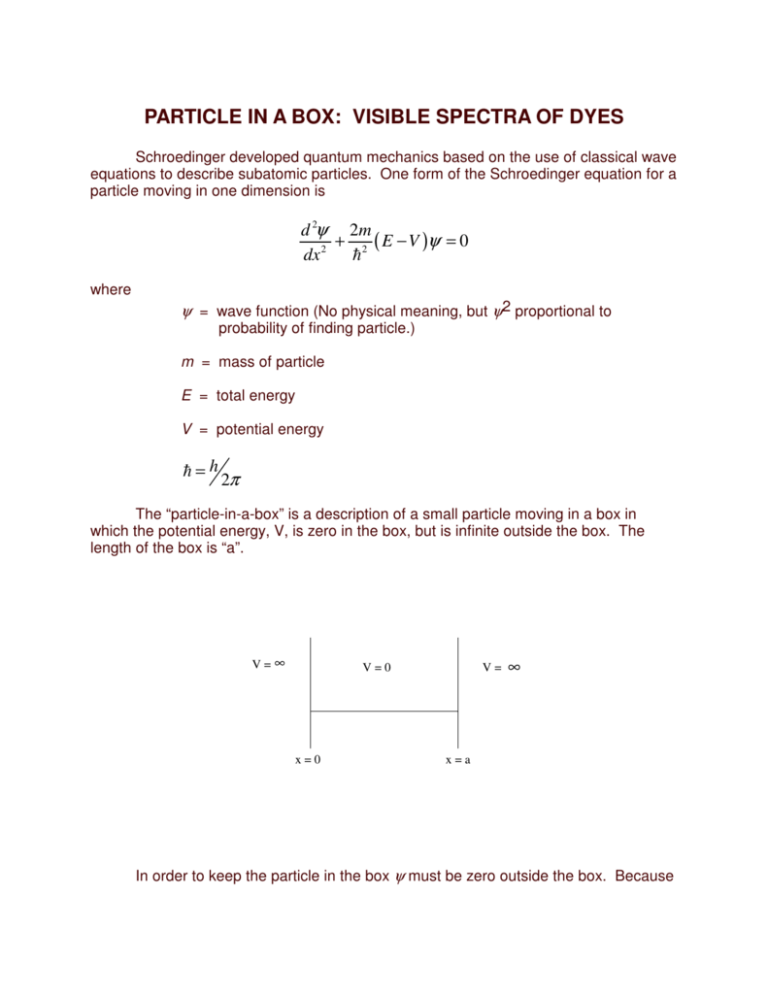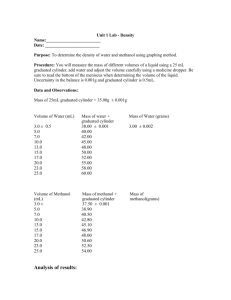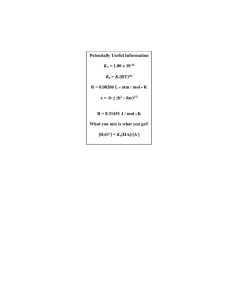PARTICLE IN A BOX: VISIBLE SPECTRA OF DYES
advertisement

PARTICLE IN A BOX: VISIBLE SPECTRA OF DYES Schroedinger developed quantum mechanics based on the use of classical wave equations to describe subatomic particles. One form of the Schroedinger equation for a particle moving in one dimension is d 2ψ 2m + 2 ( E − V )ψ = 0 dx 2 where ψ = wave function (No physical meaning, but ψ2 proportional to probability of finding particle.) m = mass of particle E = total energy V = potential energy =h 2π The “particle-in-a-box” is a description of a small particle moving in a box in which the potential energy, V, is zero in the box, but is infinite outside the box. The length of the box is “a”. V=∞ V=0 x=0 V= ∞ x=a In order to keep the particle in the box ψ must be zero outside the box. Because ψ must be continuous, ψ must also be zero at x = 0 and x = a . One solution to this problem is 2 ψ= a 1 2 2mE sin 2 At x = a , ψ = 0 ; thus sin But also 1 2mE 2 2 a=0 sin ( nπ ) = 0 Where n = 1, 2,3, So, 2mE 2 1 2 a = nπ or n 2π 2 2 E= 2ma 2 or n2h2 E= 8ma 2 (n is a quantum number 1, 2, 3, ...) 1 2 x According to our results, the energy levels are quantized! The Pauli exclusion principle requires that there be no more than two electrons in any energy level. For molecules with N π electrons there will be N/2 levels. If an electron jumps from the level n = N/2 to the lowest empty level, N/2 + 1, the change in energy, ∆E , is ∆E = E f − Ei = ( ) ( ) 2 N +1 − N 2 2 2 h2 8ma 2 Since ∆E = hν Where ν = c λ ν = frequency c = speed of light λ = wavelength ν= ∆E h ν = ( N + 1) λ= h 8ma 2 c ν or 8 mc a 2 λ= h ( N + 1) For the series of compounds we will study a = ( 2 j + 4) L where j is the number of double bonds in the polyene chain between two rings and L = 1.39 × 10−10 m the C---C bond length of order 1.5. Also N = 2j + 4. In addition the highly polarizable benzene rings require that we increase the length of the box by L. So that a = ( 2 j + 4) L + L or a = ( 2 j + 5) L Then 8 mc L2 ( 2 j + 4 ) λ= L ( 2 j + 5) 2 By increasing the box length by L 8 mc L2 ( 2 j + 5 ) λ= h The above equation may be used to estimate the wavelength of light absorbed by an electron of mass, m, in a polyene chain. PURPOSE The purpose of the experiment will be to test the particle-in-a-box model. For an electron in a box the wavelength of maximum absorption is given by 8 mc L2 ( 2 j + 5 ) λ= h EQUIPMENT AND CHEMICALS Spectrophotometer (Turner 350, Coleman 124, P. E. Lambda 3) Methanol −3 Cyanine dyes (1.00 × 10 M stock solutions in methanol, referred to as #I, #II, #III.) Compound (I) I N N C2H5 C2H5 1,1’-DIETHYL-2,2’-CYANINE IODIDE Compound (II) Cl N N C2H5 C2H5 1,1’-DIETHYL-2,2’-CARBOCYANINE CHLORIDE Compound (III) I N (III) N C2H5 C2H5 1,1’-DIETHYL-2,2’-DICARBOCYANINE IODIDE #II is also known as pinacyanol chloride. PROCEDURE −3 From 1.00 × 10 M stock solution, prepare the following solutions (Use 100 microliter micropipet.) #I Dilute 0.10 ml to 10 ml in methanol Dilute 0.10 ml to 25 ml in methanol #II Dilute 0.10 ml to 25 ml in methanol Dilute 0.10 ml to 50 ml in methanol #III Dilute 0.10 ml to 25 ml in methanol Dilute 0.10 ml to 50 ml in methanol For each dye you will have two solutions of different concentrations. Scan each solutions as follows: #I 470 - 550 nm #II 575 - 635 nm #III 675 - 735 nm Use the graph showing absorbance (A) vs. wave length (λ) for each solution. Use Beer’s law to determine the molar absorptivity for each solution of each dye. A = abc A = Absorbance a = molar absorptivity b = path length in cm c = concentration, mol/L For each solution calculate a. For a given dye the two values of a should agree within five per cent. For each dye calculate maximum λ for the electron-in-a-box and compare it with your experimental values. Literature values for maximum λ are the following: Dye #I Dye #II Dye #III 525 nm 610 nm 705 nm (From Introduction to Quantum Concepts in Spectroscopy, W. G. Laidlow, 1970, p. 35.)







